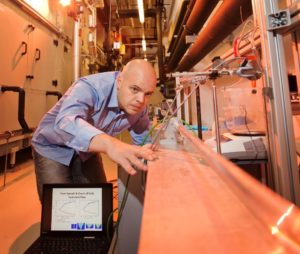October 16, 2019
Research consortium receives €3.7 million grant to tackle one of physics greatest problems
IST Austria Professor Björn Hof among a consortium of leading international physicists awarded over €3.7 million to advance the scientific understanding of turbulence.
IST Austria’s Professor Björn Hof, a physicist and fluid dynamicist, joins an international team of leading physicists which will investigate new methods aimed at improving our understanding of turbulent flows. The Simons Foundation, which was originally established in 1994, supports projects at the very frontier of basic science and actively encourages cutting-edge research that typically evolves from cross-disciplinary basic science research groups.
While the effects of turbulence are evident in our everyday lives — from the motion of breaking of a wave to the movement of weather systems — it largely remains a mystery to modern-day science. At present, Physicists can precisely describe the motion of smooth (laminar flow) using equations derived from Newton’s Laws of Motion (Navier-Stokes equations), however, when it comes to turbulent flow the predictive power of these equations quickly diminishes, even with the assistance of the world’s largest supercomputers. To break the log-jam of existing approaches, Professor Björn Hof together with a consortium of leading physicists around the world, will use concepts from statistical physics to better describe the nature of turbulent flows. From this method, Hof and his colleagues hope to develop a new conceptual framework of turbulence that may, in the future, increase the ability to predict real-world turbulent flows.
“Improving our understanding of turbulent flows is not just theoretical,” says Hof. “Finding better ways of understanding turbulent flows also has a multitude of practical applications across many areas of science such as Meteorology, Oceanography, Astrophysics and Aerodynamics. For example, a better understanding of turbulence has the potential to significantly improve the forecast of damaging weather events such as hurricanes and tornadoes and also greatly assist the modelling of aircraft aerodynamics.”
The team’s project, entitled ‘Revisiting the Turbulence Problem Using Statistical Mechanics‘, brings together some of the world’s leading scientists from Austria, UK, France, the USA and Israel to find a new way to better describe, model and conceptualize the problem of turbulent flows.
Hof adds “This project is a great example of the value of basic science and the unforeseen ramifications curiosity-driven research has on understanding our natural world.”




